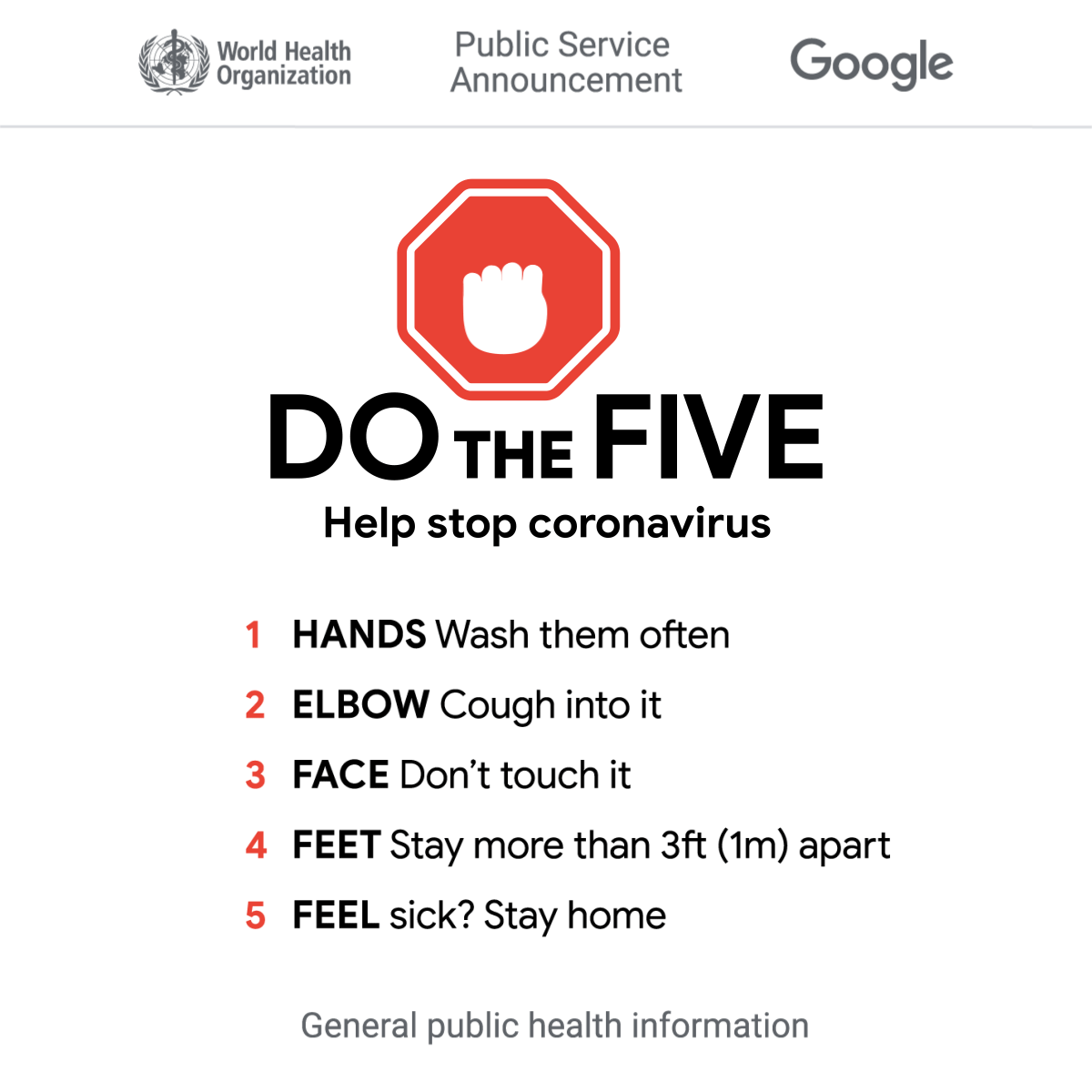 |
| blog.google |
Welcome to the social distancing edition of the blog. Before we get started on today's subject, public space and COVID-19, Blogger and Blogger Candidate would like to take a minute for this public service announcement. This is for all you who flipped a double bird at COVID-19 and continue to crowd the bars and restaurants. Yours Truly and The Candidate Forum hope your selfishness was worth it when you or loved ones get violently sick. Second, this is for those of you who continue to panic buy. Your manic hoarding is taking extremely necessary food and supplies out of the hands of the elderly and people with chronic illnesses. This kind of callousness will only help spread this terrible illness even more. Please, if you are not showing any symptoms, take sensible precautions and buy only what you need. If you, a friend, or a loved is showing any symptoms, call your doctor or go to a store-based clinic first to determine if you have a cold, the flu, or worse. Stay safe and healthy. We are all in this together. Thank you and onward.
 |
| twitter.com |
Epidemics have historically shaped our cities. In a recent post (March 2, 2020), we talked about how Valentine Seaman and, later John Snow, mapped outbreaks of yellow fever and cholera which led to one of the most significant urban planning and management developments, such as London's Metropolitan Board of Works and mid-19th century sanitation systems that emerged in the wake of public health crises (citylab.com; Mar. 6, 2020; date accessed Mar. 16, 2020). The rapid spread of COVID-19 has joined the list of pandemics like the Spanish flu of 1918-19 in New York and Mexico City; most recently the Ebola Virus Disease in 2014, all have left or will leave their permanent mark on public spaces. School of Design at the University of Melbourne, Australia professor of global urban politics Michele Acuto believes that the intersection between urban design and public health is an increasingly the field of study (Ibid).
Prof. Acuto is the director of Connected Cities Lab, a leading center of urban policy development, and has worked with the World Health Organization and the European Commission on urban health. As the University of Melbourne furiously works to develop a COVID-19 vaccine, Prof. Acuto's team is working to understand the planning aspects of pandemic readiness. CityLab recently spoke with Prof. Acuto about how COVID-19 could alter the way we live and understand cities. Prof. Acuto makes the argument for less urban density and a digital infrastructure. The less density argument runs counter to the current trend in urban planning but it makes sense. Below are excerpts from the interview.
| Prof. Michele Acuto msd.unimelb.edu.au |
CL: Much of the coverage of the new coronavirus feels unprecedented, as if this is the first time urban spaces and global movement of goods and people have give rise to the threat of pandemic. But the stories have always also been those of infectious diseases.
MA: Anyone you talk to on the urban or medical side would tell you this is not new. Yo can do parallels between COVID-19 and and many other epi- and pandemics from the plague to SARS and Ebola....COVID-19 is not as deadly as Ebola which had a mortality rate of 60% or SARS and MERS at 30%.
But if the risk of death is lower, transmission is much higher, and that makes it challenging globally. Quarantines only work insofar you can identify all dangerous cases, and with COVID-19's symptoms and delayed onset, you can't spot it that easily.... this is much more similar to the 1918 Spanish flu epidemic, which inflected 500 million and killed up to 50 million. The question is whether we are prepared to avoid that.
CL: Looking back, did we miss something in the way we were thinking about the intersection of urbanization and infectious disease? Were we looking in the wrong places?
MA: Yes, to a degree... COVID-19 is really a story of peri-urban and rural-to-urban connections, in places that often on the global map. Roger Keil, Creighton Connolly and Harris recently argued for this suburban view. They tell the story of how the spread to Germany start with a [parts] factory in the outskirts in Wuhan. A person travels from Wuhan to Germany to help with training. This is a story of peri-urban Wuhan to semi-urban, tertiary-city Bavaria...it's a much more complex urban system.
| Snohomish County, Washingto Where COVID-19 first emerged in the state snohomishcountywa.gov |
CL: This is a rich point. It's easy to look at these major and global supply chains, and say of course we have an epidemic--this how globalization plays itself out. But you're telling a different story--one about non-global cities, tertiary cities and peri-urban cities.
MA: Yes, it's actually about a much wider set of urban areas. This is the story in Washington state [where COVID-19 first emerged in Snohomish County], or the Italian story, which is still largely suburban.
CL: Part of the history of urbanization is building and managing your way out of infectious diseases, such as cholera outbreaks in the middle of the 19th century. Here's Richard Sennett on how Joseph Bazalgette and his colleagues went about developing London's response: "They were not practising an exact science. They did not apply established principles in particular cases, there were no general policies that dictated best practices." They experimented and learned as they went along, he argues. How do you conceive of the design approach to managing outbreaks in everything from global to tertiary cities?
MA: It's a bit early to take on lessons learned from COVID-19, but you'd probably have a big conversation about the value versus the risks of densification. Clearly densification is and has been the with problem of this. COVID-19 puts a fundamental challenge to how we manage urbanization. Hong Kong has 17,311 people per square mile. Rethinking density management is a key for long-term survival pandemic world,...
Part of this means thinking about decentralization of essential services. Singapore had to shut down its main hospitals during SARS. Many countries such as Italy are considering door-to-door testing.... Bubbling up are some core questions about what we've been told is desirable urbanization versus what makes sense from infectious disease perspective.
 |
| LeCorbusier theguardian.com |
CL: Here's a difficult question. Even Le Corbusier, who prized efficiency and movement, understood the value of people bumping into each other. It gives cities their energy and cosmopolitanism its effect. I wonder if you think decentralized city--a London of villages, Mayor Hidalgo's 15-minute Paris--will be part of our response?
MA: Here's a way to think about it. SARS got some people to think about cities and their connectivity as a fundamental factor. Fast-forward to Ebola and that got people to think about the coexistence of cities in the Global North and South, and the ferocity of the city itself--...
Fast forward to now, and we've moved beyond Global North-Global South thinking. It's one very large system, given it's really about the connection between for example, [the Italian village of] Codogno and the outskirts of Wuhan....
We need to begin with a new imagination of the urban data we relay on. The best think a professional probably looks at in this moment is Johns Hopkins's CSSE aggregator of information. It splashes together data sources from WHO, NHS, and so on.... there's better information by aggregating different sources of information.
But this also bring into play the current digital revolution and the challenges of evidence that has different levels of legitimacy. Had this happened not,... China but in some place like India with very strong informal settlements, you'd potentially be arguing that something like Slum Dweller International,..., would be the best-suited entity to support the collection of information. You've gotten something there about the legitimacy of different types of urban knowledge and the need to rethink who are the right sources of it.
| Which area will experience radical post-pandemic transformation? Denver, Colorado denverpost.com |
CL: Moving from that information to changes within the built environment again, we know the management of water and waste helped remake cities. Can you predict the area where we might see a radical transformation coming out of this?
MA: We must remember you will be weighing such changes in the context of climate change ans sustainability as well. If you spread the city rather than densify, that would to go with much better connectivity of public transport. What should change--the decentralization of services, better management of supplies, nets of smaller entities..., for instance--is different from will. Will market forces sway the things we do toward what's marketable and economically profitable, versus saying this clearly is a call for redundancy in public health and public transport?
One thing I've barely heard talked about is the digital response here,.... It existed a bit during Ebola, but not in the same size as this. Major services like Tencent and Alibaba can tell you who is sick in your neighborhood, and people are making daily based on the whole digital infrastructure....
Modern planning and civil engineering were born out of the mid-19th century development of sanitation in response to the spread of malaria and cholera in cities. Digital infrastructures might be the sanitation of our time.
No comments:
Post a Comment